FDG-PET reproducibility in tumor-bearing mice: comparing a traditional SUV approach with a tumor-to-brain tissue ratio approach
2017.01.17.
Morten Buska, et al., ACTA ONCOLOGICA, 2017
Summary
Current [F-18]-fluorodeoxyglucose positron emission tomography (FDG-PET) procedures in tumor-bearing mice typically includes fasting, anesthesia, and standardized uptake value (SUV)-based quantification. Such procedures may be inappropriate for prolonged multiscan experiments. The working hypothesis was that normalization of tumor FDG retention relative to a suitable reference tissue may improve accuracy as this method may be less susceptible to uncontrollable day-to-day changes in blood glucose levels, physical activity, or unnoticed imperfect tail vein injections.
Conclusions
Multimodality scanners allow tissue delineation and normalization of tumor FDG uptake relative to reference tissues. Normalization to brain, but not liver or kidney, improved scan reproducibility considerably and was superior to traditional SUV quantification in i.v. tracer-injected animals. Day-to-day variability in SUV’s was lower in i.p. than in i.v. injected animals, and i.p. injections may therefore be a valuable alternative in prolonged rodent studies, where repeated vein injections are undesirable.
Hogyan segíthetünk Önnek?
További termékinformációkért, vagy támogatásért keresse szakértőinket!
Vegye fel a kapcsolatot

